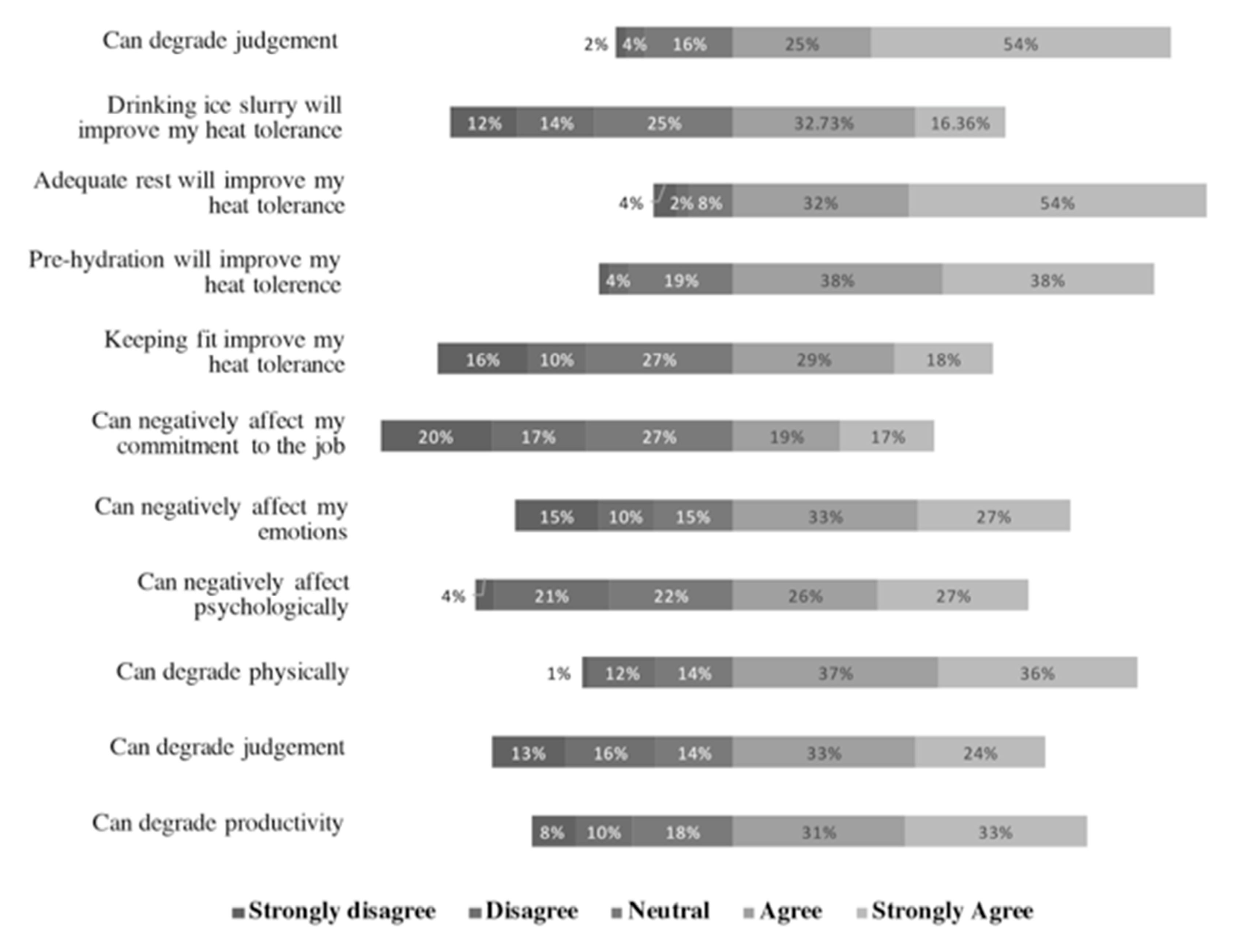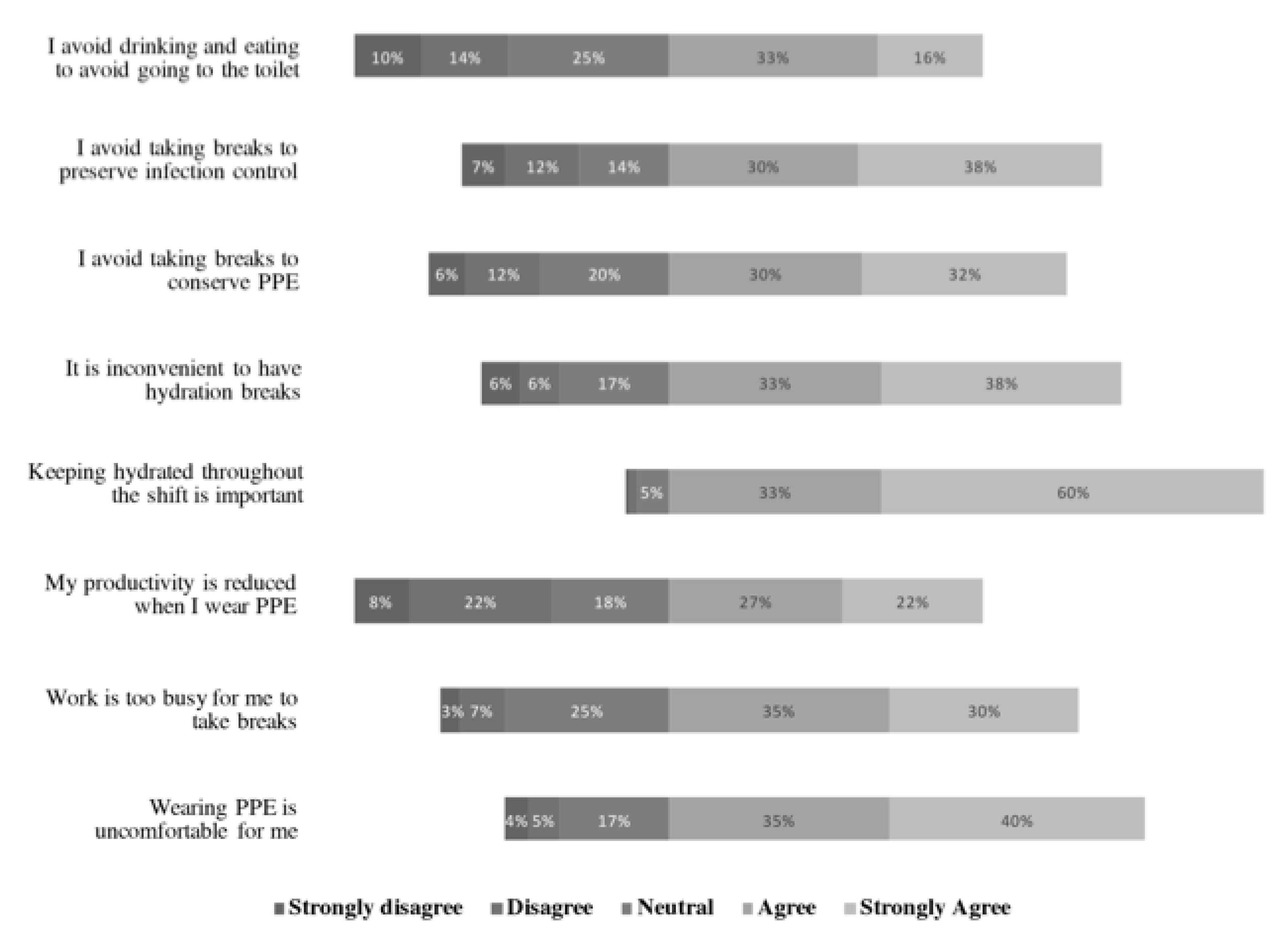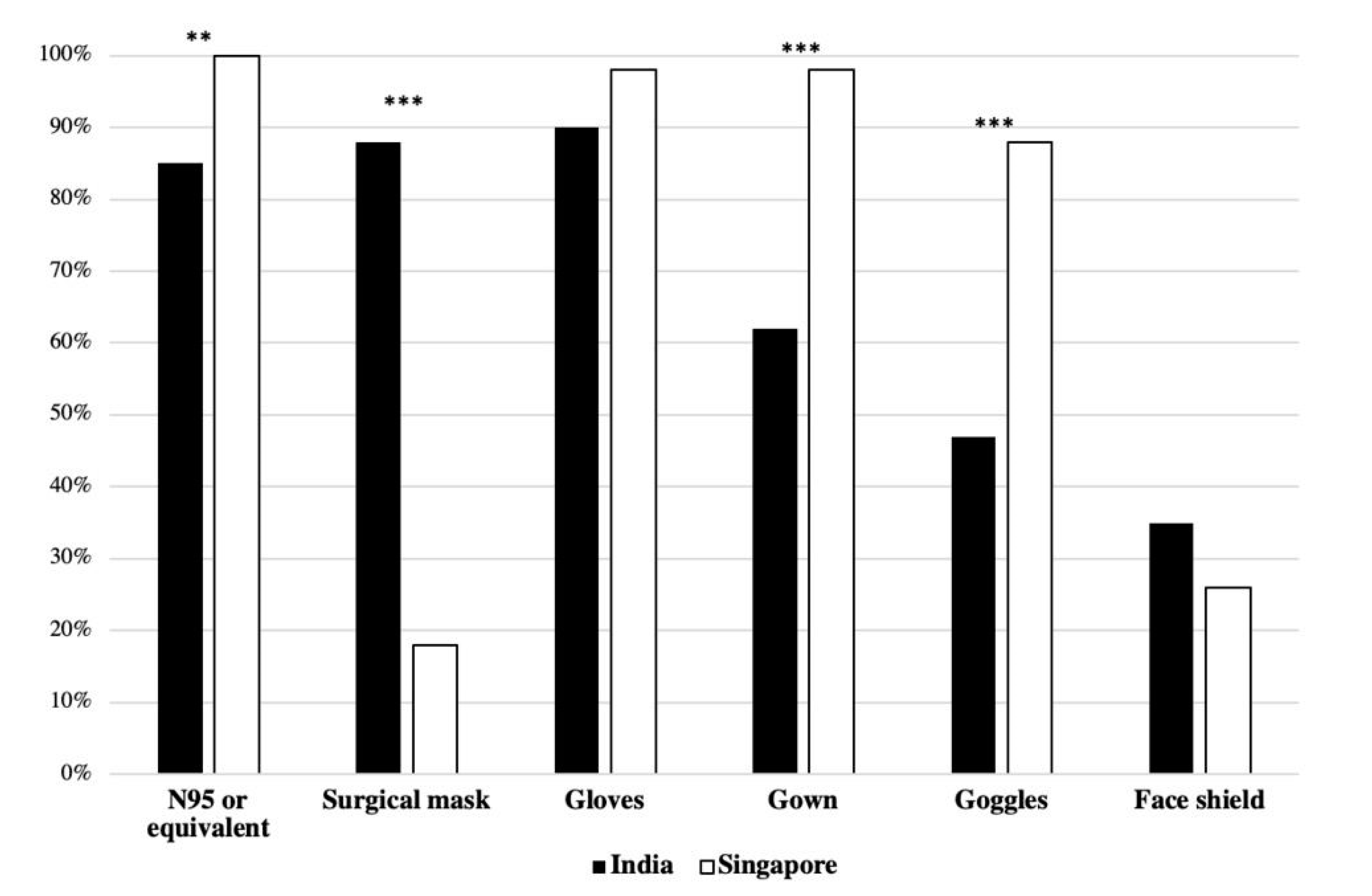Heat Stress and Thermal Perception amongst Healthcare Workers during the COVID-19 Pandemic in India and Singapore
Abstract
1. Introduction
2. Materials and Methods
2.1. Participants
2.2. Design
2.3. Procedure
2.3.1. Questionnaire
2.3.2. Assessment of Environmental Conditions
2.3.3. Ice Slurry
2.4. Statistical Analysis
3. Results
3.1. Demographic Details and Work Information
3.2. Knowledge on Heat Stress and PPE Use
- “Heat stress can degrade productivity” (Wilcoxon rank-sum test statistics (W) = 2216.5, p < 0.01);
- “Heat stress can degrade judgment” (W = 2207, p < 0.01);
- “Heat stress can negatively affect me psychologically” (W = 1905, p < 0.01);
- “Heat stress can negatively affect emotions” (W = 1817, p < 0.01);
- “Pre-hydration can improve heat tolerance” (W = 3824.5, p < 0.01);
- “Drinking ice slurry will improve heat tolerance” (W = 1898.5, p < 0.01).
- “Heat stress can degrade me physically”;
- “Keeping fit can improve heat tolerance”;
- “PPE prevents sweat evaporation”.
3.3. Attitudes towards PPE Usage
- “Wearing PPE is uncomfortable for me” (W = 3719.5, p < 0.01);
- “I avoid breaks to conserve PPE” (W = 4114.5, p < 0.01);
- “I avoid breaks to preserve infection control” (W = 4492.5, p < 0.01);
- “I avoid eating and drinking to avoid going to the toilet” (W = 3889, p < 0.01).
- “Work is too busy for me to take breaks”;
- “My productivity is reduced when wearing PPE”;
- “Keeping hydrated throughout the shift is important”;
- “It is inconvenient to have hydration breaks”;
- “PPE will prevent sweat evaporation”.
3.4. PPE Usage Practices and Symptoms of Heat Stress
- (1)
- N95 masks: Singapore (n = 55, 100%) vs. India (n = 93, 85%) (χ2(1) = 7.878, p < 0.01);
- (2)
- Gown: Singapore (n = 54, 98%) vs. India (n = 68, 62%) (χ2(1) = 22.93, p < 0.01);
- (3)
- Goggles: Singapore (n = 48, 88%) vs. India (n = 52, 47%) (χ2(1) = 22.93, p < 0.01).
3.5. Ice Slurry
4. Discussion
5. Conclusions
Author Contributions
Funding
Acknowledgments
Conflicts of Interest
References
- World Health Organisation. Coronavirus Disease (COVID-19) Situational Report 51. Available online: https://www.who.int/docs/default-source/coronaviruse/situation-reports/20200311-sitrep-51-covid-19.pdf?sfvrsn=1ba62e57_10 (accessed on 13 October 2020).
- World Health Organisation. Coronavirus Disease (COVID-19) Weekly Epidemiological Update. Available online: https://www.who.int/docs/default-source/coronaviruse/situation-reports/20200831-weekly-epi-update-3.pdf?sfvrsn=d7032a2a_4 (accessed on 13 October 2020).
- HHS. Pandemic Influenza Plan: 2017 Update; Department of Health and Human Services, Ed.; HHS: Sacramento, CA, USA, 2017. [Google Scholar]
- Adams, J.G.; Walls, R.M. Supporting the Health Care Workforce During the COVID-19 Global Epidemic. JAMA 2020, 323, 1439–1440. [Google Scholar] [CrossRef] [PubMed]
- World Health Organisation. Rational Use of Personal Protective Equipment for Coronavirus Disease (COVID-19) and Considerations during Severe Shortages; World Health Organisation: Geneva, Switzerland, 2020. [Google Scholar]
- Zhou, M.; Tang, F.; Wang, Y.; Nie, H.; Zhang, L.; You, G.; Zhang, M. Knowledge, attitude and practice regarding COVID-19 among health care workers in Henan, China. J. Hosp. Infect. 2020, 105, 183–187. [Google Scholar]
- Kjellstrom, T.; Holmer, I.; Lemke, B. Workplace heat stress, health and productivity–an increasing challenge for low and middle-income countries during climate change. Glob. Health Action 2009, 2, 2047. [Google Scholar] [CrossRef] [PubMed]
- Kuklane, K.; Lundgren, K.; Gao, C.; Löndahl, J.; Hornyanszky, E.D.; Östergren, P.-O.; Becker, P.; Samuels, M.C.; Gooch, P.; Sternudd, C. Ebola: Improving the design of protective clothing for emergency workers allows them to better cope with heat stress and help to contain the epidemic. Ann. Occup. Hyg. 2015, 59, 258–261. [Google Scholar] [PubMed]
- Potter, A.W.; Gonzalez, J.A.; Xu, X. Ebola Response: Modeling the Risk of Heat Stress from Personal Protective Clothing. PLoS ONE 2015, 10, e0143461. [Google Scholar] [CrossRef] [PubMed]
- Weather Underground. Chennai, Tamil Nadu, India Weather History. Available online: https://www.wunderground.com/history/monthly/in/chennai/VOMM/date/2020-6 (accessed on 16 October 2020).
- Weather Underground. Singapore, South East, Singapore Weather History. Available online: https://www.wunderground.com/history/monthly/sg/singapore/WSSS/date/2020-6 (accessed on 16 October 2020).
- Hussain, I.; Majeed, A.; Imran, I.; Ullah, M.; Hashmi, F.K.; Saeed, H.; Chaudhry, M.O.; Rasool, M.F. Knowledge, Attitude, and Practices Toward COVID-19 in Primary Healthcare Providers: A Cross-Sectional Study from Three Tertiary Care Hospitals of Peshawar, Pakistan. J. Community Health 2020, 6, 1–9. [Google Scholar] [CrossRef] [PubMed]
- Ogolodom, M.; Mbaba, A.; Alazigha, N.; Erondu, O.; Egbe, N. Knowledge, Attitudes and Fears of HealthCare Workers towards the Corona Virus Disease (COVID-19) Pandemic in South-South, Nigeria. Health Sci. J. 2020, 1, 1–10. [Google Scholar]
- Lemke, B.; Kjellstrom, T. Calculating workplace WBGT from meteorological data: A tool for climate change assessment. Ind. Health 2012, 50, 267–278. [Google Scholar] [CrossRef]
- Fanger, P.O. Assessment of man’s thermal comfort in practice. Occup. Environ. Med. 1973, 30, 313–324. [Google Scholar] [CrossRef]
- Chinnadurai, J.; Venugopal, V.; Kumaravel, P.; Paramesh, R. Influence of occupational heat stress on labour productivity a case study from Chennai, India. Int. J. Product. Perform. Manag. 2016, 65, 245–255. [Google Scholar] [CrossRef]
- Hancock, P.A.; Vasmatzidis, I. Effects of heat stress on cognitive performance: The current state of knowledge. Int. J. Hyperth. 2003, 19, 355–372. [Google Scholar] [CrossRef] [PubMed]
- Xiang, J.; Bi, P.; Pisaniello, D.; Hansen, A.; Sullivan, T. Association between high temperature and work-related injuries in Adelaide, South Australia, 2001–2010. Occup. Environ. Med. 2014, 71, 246. [Google Scholar] [CrossRef]
- Morabito, M.; Messeri, A.; Crisci, A.; Bao, J.; Ma, R.; Orlandini, S.; Huang, C.; Kjellstrom, T. Heat-related productivity loss: Benefits derived by working in the shade or work-time shifting. Int. J. Product. Perform. Manag. 2020, 1–19. [Google Scholar] [CrossRef]
- Kjellstrom, T.; Kovats, R.S.; Lloyd, S.J.; Holt, T.; Tol, R.S. The direct impact of climate change on regional labor productivity. Arch. Environ. Occup. Health 2009, 64, 217–227. [Google Scholar] [CrossRef]
- Venugopal, V.; Latha, P.; Shanmugam, R.; Krishnamoorthy, M.; Johnson, P. Occupational heat stress induced health impacts: A cross-sectional study from South Indian working population. Adv. Clim. Chang. Res. 2020, 11, 31–39. [Google Scholar] [CrossRef]
- Rowlinson, S.; YunyanJia, A.; Li, B.; ChuanjingJu, C. Management of climatic heat stress risk in construction: A review of practices, methodologies, and future research. Accid. Anal. Prev. 2014, 66, 187–198. [Google Scholar] [CrossRef]
- Tabah, A.; Ramanan, M.; Laupland, K.B.; Buetti, N.; Cortegiani, A.; Mellinghoff, J.; Conway Morris, A.; Camporota, L.; Zappella, N.; Elhadi, M.; et al. Personal protective equipment and intensive care unit healthcare worker safety in the COVID-19 era (PPE-SAFE): An international survey. J. Crit. Care 2020, 59, 70–75. [Google Scholar] [CrossRef]
- Roberts, I.; Perner, A. Ebola virus disease: Clinical care and patient-centred research. Lancet 2014, 384, 2001–2002. [Google Scholar] [CrossRef]
- Yeo, Z.W.; Fan, P.W.; Nio, A.Q.; Byrne, C.; Lee, J.K. Ice slurry on outdoor running performance in heat. Int. J. Sports Med. 2012, 33, 859–866. [Google Scholar] [CrossRef]
- Bach, A.J.E.; Maley, M.J.; Minett, G.M.; Zietek, S.A.; Stewart, K.L.; Stewart, I.B. An Evaluation of Personal Cooling Systems for Reducing Thermal Strain Whilst Working in Chemical/Biological Protective Clothing. Front Physiol. 2019, 10, 424. [Google Scholar] [CrossRef] [PubMed]
- Lee, J.; Yeo, Z.; Nio, A.; Koh, A.; Teo, Y.; Goh, L.; Tan, P.; Byrne, C. Cold drink attenuates heat strain during work-rest cycles. Int. J. Sports Med. 2013, 34, 1037–1042. [Google Scholar] [CrossRef]
- Alhadad, S.B.; Tan, P.M.S.; Lee, J.K.W. Efficacy of Heat Mitigation Strategies on Core Temperature and Endurance Exercise: A Meta-Analysis. Front. Physiol. 2019, 10, 71. [Google Scholar] [CrossRef]
- Mora-Rodriguez, R.; Del Coso, J.; Hamouti, N.; Estevez, E.; Ortega, J.F. Aerobically trained individuals have greater increases in rectal temperature than untrained ones during exercise in the heat at similar relative intensities. Eur. J. Appl. Physiol. 2010, 109, 973–981. [Google Scholar] [CrossRef]
- Kuwahara, T.; Inoue, Y.; Taniguchi, M.; Ogura, Y.; Ueda, H.; Kondo, N. Effects of physical training on heat loss responses of young women to passive heating in relation to menstrual cycle. Eur. J. Appl. Physiol. 2005, 94, 376–385. [Google Scholar] [CrossRef]
- Byrne, C.; Lee, J.K.; Chew, S.A.; Lim, C.L.; Tan, E.Y. Continuous thermoregulatory responses to mass-participation distance running in heat. Med. Sci. Sports Exerc. 2006, 38, 803–810. [Google Scholar] [CrossRef]
- GHHIN. Q&A: How Can Health Workers and Other Responders Manage Heat Stress While Wearing Personal Protective Equipment (PPE)? Available online: http://www.ghhin.org/heat-and-covid-19/PPE (accessed on 18 August 2020).
- Morabito, M.; Messeri, A.; Crisci, A.; Pratali, L.; Bonafede, M.; Marinaccio, A. Heat warning and public and workers’ health at the time of COVID-19 pandemic. Sci. Total Environ. 2020, 738, 140347. [Google Scholar] [CrossRef]
- Morabito, M.; Messeri, A.; Noti, P.; Casanueva, A.; Crisci, A.; Kotlarski, S.; Orlandini, S.; Schwierz, C.; Spirig, C.; Kingma, B.R. An Occupational Heat–Health Warning System for Europe: The HEAT-SHIELD Platform. Int. J. Environ. Res. Public Health 2019, 16, 2890. [Google Scholar] [CrossRef] [PubMed]



| Factors | India | Singapore |
|---|---|---|
| n = 110 | n = 55 | |
| Age (years) | 31.0 (26.0–38.0) | 29.0 (27.0–33.0) |
| W = 3075.5, p = 0.48 | ||
| Male gender | 64 (58%) | 20 (36.4%) * |
| χ2(1) = 10.9, p < 0.01 | ||
| BMI (kg/m2) | 24.4 (22.5–26.6) | 22.0 (18.8–24.8) * |
| W = 3569, p = 0.014 | ||
| WBGT (°C) | 30.2 (29.1–31.8) | 20.0 (19.3–26.05) *** |
| W = 5589.5, p < 0.01 | ||
| Role | ||
| Medical | 45 (39%) | 21 (42%) |
| Nursing | 33 (29%) | 28 (56%) |
| Operations | 4 (4%) | 0 (0%) |
| Sanitary | 5 (4%) | 0 (0%) |
| Others | 28 (24%) | 1 (2%) |
| Location | ||
| Tentage | 2 (2%) | 26 (52%) |
| Fever Facility (FF) | 24 (21%) | 26 (52%) |
| Clean Area | 25 (22%) | 14 (28%) |
| Others | 64 (57%) | 2 (4%) |
| Factors | India | Singapore |
|---|---|---|
| n = 110 | n = 55 | |
| Days/week in PPE | 6 (5–6) | 5 (4–5) *** |
| W = 3854, p < 0.01 | ||
| Hours/shift in PPE | 6 (5–8) | 8 (8–8.15) *** |
| W = 1516, p < 0.01 | ||
| Working in A/C | 27 (25%) | 34 (62%) *** |
| χ2(1) = 20.29, p < 0.01 | ||
| Dedicated rest area | 46 (42%) | 55 (100%) *** |
| χ2(1) = 53.91, p < 0.01 | ||
| Time taken to don PPE (minutes) | 7 (5–10) | 3 (2–5) *** |
| W = 4850.5, p < 0.01 | ||
| Remove PPE on breaks | 66 (60%) | 54 (98.2%) *** |
| χ2(1) = 25.06, p < 0.01 | ||
| Symptoms in PPE | ||
| Headache | 36 (33%) | 12 (22%) |
| χ2(1) = 1.62, p = 0.20 | ||
| Dizziness | 7 (6%) | 16 (29%) *** |
| χ2(1) = 13.95, p < 0.01 | ||
| Thirst | 98 (85%) | 46 (92%) |
| χ2(1) = 0.8973, p = 0.34 | ||
| Vomiting | 0 (0%) | 0 (0%) |
| Excessive sweating | 95 (86%) | 50 (90%) |
| χ2(1) = 0.3485, p = 0.56 | ||
| Breathing difficulty | 27 (25%) | 7 (13%) |
| χ2(1) = 2.45, p = 0.12 | ||
| Dehydration | 27 (23%) | 3 (6%) ** |
| χ2(1) = 7.75, p < 0.01 | ||
| Exhaustion | 86 (78%) | 42 (76%) |
| χ2(1) = 0.452, p = 0.76 | ||
| Wanting to go comfort zone | 94 (86%) | 42 (76%) |
| χ2(1) = 1.51, p = 0.22 | ||
| Sick leave | 3 (3%) | 4 (8%) |
| Fisher’s exact: p = 0.22 |
Publisher’s Note: MDPI stays neutral with regard to jurisdictional claims in published maps and institutional affiliations. |
© 2020 by the authors. Licensee MDPI, Basel, Switzerland. This article is an open access article distributed under the terms and conditions of the Creative Commons Attribution (CC BY) license (http://creativecommons.org/licenses/by/4.0/).
Share and Cite
Lee, J.; Venugopal, V.; Latha, P.K.; Alhadad, S.B.; Leow, C.H.W.; Goh, N.Y.D.; Tan, E.; Kjellstrom, T.; Morabito, M.; Lee, J.K.W. Heat Stress and Thermal Perception amongst Healthcare Workers during the COVID-19 Pandemic in India and Singapore. Int. J. Environ. Res. Public Health 2020, 17, 8100. https://doi.org/10.3390/ijerph17218100
Lee J, Venugopal V, Latha PK, Alhadad SB, Leow CHW, Goh NYD, Tan E, Kjellstrom T, Morabito M, Lee JKW. Heat Stress and Thermal Perception amongst Healthcare Workers during the COVID-19 Pandemic in India and Singapore. International Journal of Environmental Research and Public Health. 2020; 17(21):8100. https://doi.org/10.3390/ijerph17218100
Chicago/Turabian StyleLee, Jimmy, Vidhya Venugopal, P K Latha, Sharifah Badriyah Alhadad, Clarence Hong Wei Leow, Nicholas Yong De Goh, Esther Tan, Tord Kjellstrom, Marco Morabito, and Jason Kai Wei Lee. 2020. "Heat Stress and Thermal Perception amongst Healthcare Workers during the COVID-19 Pandemic in India and Singapore" International Journal of Environmental Research and Public Health 17, no. 21: 8100. https://doi.org/10.3390/ijerph17218100
APA StyleLee, J., Venugopal, V., Latha, P. K., Alhadad, S. B., Leow, C. H. W., Goh, N. Y. D., Tan, E., Kjellstrom, T., Morabito, M., & Lee, J. K. W. (2020). Heat Stress and Thermal Perception amongst Healthcare Workers during the COVID-19 Pandemic in India and Singapore. International Journal of Environmental Research and Public Health, 17(21), 8100. https://doi.org/10.3390/ijerph17218100







